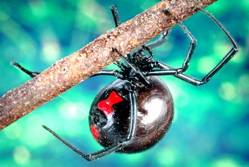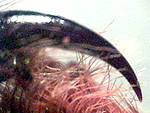Black Widow Spiders
Genus Latrodectus
Online Biology Dictionary
|
|

|
|
Black Widow (Latrodectus mactans) |

|
|
Magnified spider fang. The hairy region below is the
proximal segment of the
chelicera. The fang is hollow, allowing injection
of venom. More about spider
anatomy >>. |

|
|
Worldwide distribution of genus Latrodectus (Enlarged image) |
Black widow spiders — spiders of the genus Latrodectus — account for more deaths worldwide than any other type of spider. Latrodectid spiders are small and therefore harder to detect than larger spiders, and their venom is far more potent. The poison is a neurotoxin known as latrotoxin. Though potent, it is much slower-acting than the neurotoxin of the golden poison frog, which can cause immediate death.
Compared with those of most other spiders, the fangs of black widows are small—in females, only about 1 mm (0.04 in) long. But they are still long enough to administer a dangerous bite. Males, which have smaller poison glands and fangs than females, inject much less venom and less deeply. Even in the case of a female, the volume injected is only .02-.03 mg, not enough, in most cases, to kill an adult human being.
In Latrodectus mactans (see picture, above right), which is found in North and South America, females are a shiny, coal black, 10 mm long, and have round, nearly spherical, abdomens. Males are only about half as long and have elongated abdomens. Usually the ventral side of the female’s abdomen has a bright red, usually hourglass-shaped, marking (but this is not always present). A male’s abdomen has four pairs of red-and-white stripes on its sides.
Return to Spider anatomy >>
Return to Online Biology Dictionary >>
Most shared on Macroevolution.net:
Human Origins: Are we hybrids?
On the Origins of New Forms of Life
Mammalian Hybrids
Cat-rabbit Hybrids: Fact or fiction?
Famous Biologists
Dog-cow Hybrids
Georges Cuvier: A Biography
Prothero: A Rebuttal
Branches of Biology
Dog-fox Hybrids